Gibson Guitars – The Les Paul – An American Classic
Among the thousands of guitar players around the globe, the Gibson Les Paul guitar is one of the guitars considered the ultimate six-string electric guitar to own. As the guitar industry exploded over the past three or four decades, more young players have been able to start their musical careers on one of many Les Paul-style guitars (or at least a good copy). Vintage guitars from Gibson attract outrageous prices.
What makes this king of music instruments so desirable?
Beyond the Gibson guitar name, and the obvious draw of Les Paul’s name, the quality construction and sound of this instrument certainly pull in dozens of players. The Gibson guitar Les Paul, in its basic form, is known for a “fat” sound, a full sound and, when set up properly, serious sustain.
It’s not surprising when a young player or inexperienced guitar buyer is overwhelmed by the array of guitars available. Dozens of different manufacturers offer instruments of varying quality. But nearly every player that chooses a Gibson guitars Les Paul knows that the results will be favorable and the sound produced will be pleasing to the ear.
2005 Gibson Les Paul '58 Reissue in Iced Tea in original case
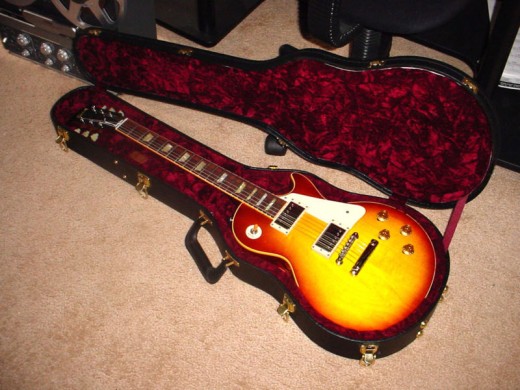
Lester William Polfus (Les Paul)
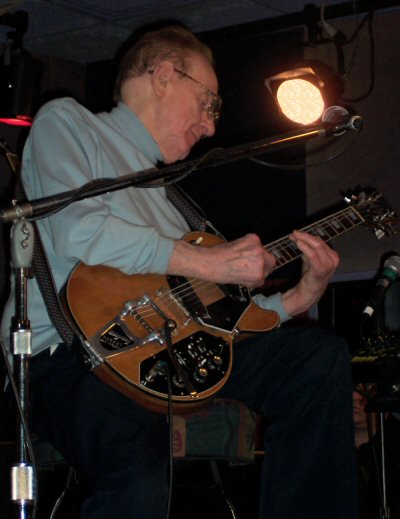
How Gibson Les Paul Guitars got started
Gibson acoustic guitars were the forerunner of Gibson as we know it today. They began producing guitars long before the company came out with its first electric. Four decades of acoustic guitar experience served the builders and engineers well when they made the move into electric musical instruments in the 1930s. The ES-150 and ES-175 were two of the first, successful Gibson electric guitars that set the bar for later Gibson instruments and for other manufacturers.
According to information from the company, Gibson guitars moved into the solid-body electric field in the early 1950s, introducing a Les Paul model in 1952. Wisconsin-born Les Paul (the man) was an excellent jazz and pop guitarist, but was also known as an excellent technician and inventor. According to an excellent piece at expresmilwaukee.com, by David Luhrssen and Martin Jack Rosenblum, Les Paul first tried to amplify a Sears guitar using a phonograph needle and radio receiver. He reportedly built a solid-body guitar in 1934, which was the forerunner of the Gibson guitars of the early 1950s.
Typical Gibson Tune-o-matic bridge with stopbar
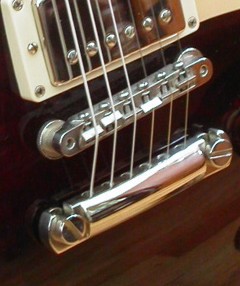
Custom guitars make their entrance
The Custom model had the tune-o-matic bridge, considered a standard in the electric guitar industry. Early bridges of this type had a "thumb wheel" for adjusting string height. But players had to loosen the strings to make the move. An improved tune-o-matic bridge has a slothead adjustment so that string height can be changed with a flathead screwdriver.
One of the features that players in rock, jazz and blues love about the Les Paul is that wide, silky neck. A guitarist switching from a Fender or Peavey, for example, will find the Gibson neck a bit wider. It may take some getting used to, in fact. But there is something about the heavy feel of the Les Paul that makes it just right for many guitarists in all genres.
Jimmy Page with double neck Gibson guitar
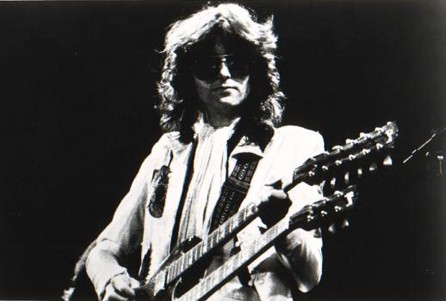
Gibson Electric Guitar players
Many "stars" have been good endorsements for Gibson guitars. It may be common to see Led Zeppelin's legendary player, Jimmy Page, playing a double-neck, SG-style Gibson on occasion. But the classic photo of this rock icon may be the bow drawing across the neck of a Les Paul. Of course, Page wasn't the only rock star of the 1960s and 1970s to use this model. Steve Howe, who played a Les Paul on several tunes from Yes, used the Gibson to keep up with his band mates. When Rick Wakeman set up his cubbyhole of keyboards and Chris Squire took off on a virtuoso bassline, Howe could depend on the Les Paul to give his phenomenal talent the correct voice.
Gibson Custom Zakk Wylde Signature Les Paul Electric Guitar - Bull's Eye
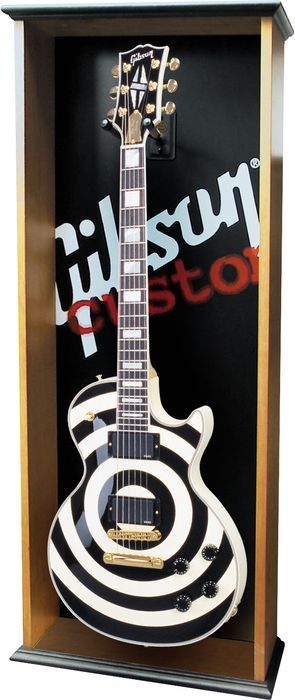
The currently popular Zakk Wylde has a few special models of the Les Paul, which he uses for his unique brand of rock/blues/metal style. The bullseye pattern is quite familiar to Wylde fans, but the key to a great Les Paul sound onstage or in the studio lies in the pickups, the wood and the setup. Wylde's models use an EMG81 pickup at the bridge and an EMG85 for the neck pickup. The body on the Custom Zakk Wylde Signature Les Paul is made of mahogany. The lacquer finish is complemented by gold hardware.
There is some discussion about the use of a Les Paul in Jazz, and while the number of players in that field on Les Pauls may be limited, it is important to note that the man whose name appears on the headstock was a jazz and pop musician. Others, such as Al DiMeola, used Les Paul guitars for some recordings.
Gibson Les Paul guitar costs
What does it cost to get the incomparable Les Paul sound?
Well, there are many styles and combinations of features under the Les Paul umbrella. But a few examples will help guide the player interested in getting this standard of musical instruments.
The Gibson Les Paul Studio, first available in about 1983, is available new for around $1,200 to $1,300 from retailers. Another desirable Les Paul model is the Standard. The early 2000s version had a smaller headstock similar to some very early Gibson guitars. Retail shops are offering the standard with what they call a 60s style neck that players will find a bit slimmer and faster. The bigger, rounded neck is also available. The newer Standard model has a rosewood fingerboard.
For the careful buyer, eBay remains a good source of Gibson Les Paul purchases (we have bought half a dozen excellent, genuine Les Paul guitars from eBay both in the Uk and the US). Shipping a Les Paul overseas from an unknown seller isn't as traumatic as you might thinlk, either!
More than anything, you need to beware of fake listings, as for expensive guitars, eBay seems to have more fraudsters than most categories of sale.
But if you can contact the buyer and discuss, and proceed with caution, often in our experience there are genuine reasons for sale.
We have even purchased our (genuine) limited edition Showcase Gibson Les Paul frojm eBay, as well as several other Les Paul's that we sold on as they just weren't right for us.
Humbuckers on a Gibson guitar
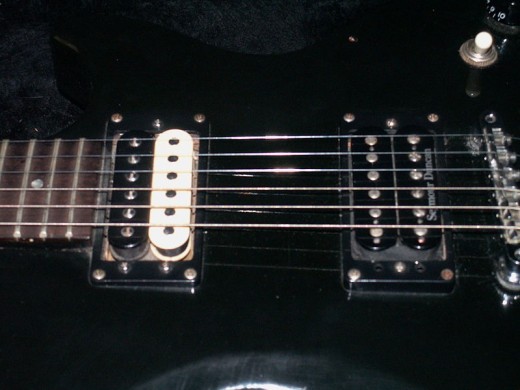
Most players are familiar with the humbucker pickups, one of the keys to the Gibson sound. The key to the Humbucker pickup sound lies in the two, out-of-phase coils that cancel each other out, to put it simply. This "bucks" the hum, thus the name. It's quieter, fat and warm.
Gibson USA Presents The Les Paul Standard
The Standard being offered for about $2,500 has Burstbucker V pickups for what some retailers call a more seductive tone. Some guitarists swear by the improvements made with this humbucking pickup. Others stay with the "older" style humbucking pickups or go with a similar pickup from another supplier, then install them in their Les Paul.
Here are the specs for the Les Paul Standard, from the Gibson catalog:
- Carved AA maple top, mahogany back, mahogany neck with nice inlay work. The 22-fret scale is 24 ¾ inches. At the nut, the neck is 1 11/16 inches wide. This model has the stop bar tailpiece and a three-way pickup switch.
Gibson USA 2008 Slash Les Paul Signature
How to tell a genuine Les Paul?
Gibson material shows at least 13 distinct Les Paul models that can be purchased new. They are:
- HD.6-X Pro Digital;
- Supreme;
- Standard Premium Plus;
- Robot LP Studio Ltd.;
- 2008 Standard;
- Standard;
- Traditional;
- Classic Antique;
- Classic;
- Studio Premium Plus;
- Billie Joe Armstrong LP Junior;
- BFG Limited;
- Studio.
Perhaps the best place to start when considering the purchase of a classic, vintage Les Paul, rather than a brand new one, is the Blue Book of Electric Guitars, Sixth Edition, Gibson Serialization, Edited by S.P. Fjestad. Even that austere compilation warns that identifying guitars solely by serial number can be difficult, even impossible. However, help is available. Go to page 3 of that document and see that Gibson began a new serial number system in 1961.
Another source of electric guitar information notes the general knowledge that Gibson solid body serial numbers are located on the back of the headstock. For the years 1953 through 1961, the first digit in a serial number composed of 5 or 6 digits can usually determine the year.
The 1961-1975 system was not necessarily an improvement, in some collector's minds. Some numbers are allegedly duplicated and there may be inconsistencies. But here is an example of a 1964-1965 serial number: 200000-290000.
From 1977 on, a standard serial number was used. The first number and fifth number can identify the year: 8997653 or 1986.
A tour in the GIBSON guitar Factory
Summary
For the beginner or the experienced musician, careful shopping and information from a knowledgeable guitar man/technician are essential when looking for that perfect Gibson guitars Les Paul. And don't forget, Gibson bass guitars and acoustics also bear the Gibson name… Some newcomers may even want to consider the excellent copies bearing the Epiphone guitars name. But that's another story altogether.
This hub brought to you...
by Julie-Ann Amos, professional writer, and owner of international writing agency www.ExquisiteWriting.com
Why not create your own HubPages? It's fun and you can make revenue from Adsense and other revenue streams on your pages. JOIN HUBPAGES NOW - SIMPLY CLICK HERE...
This work is licensed under the Creative Commons Attribution-Non-Commercial-No Derivative Works 3.0 Unported License. To view a copy of this licence, visit http://creativecommons.org/licenses/by-nc-nd/3.0/ or send a letter to Creative Commons, 171 Second Street, Suite 300, San Francisco, California 94105, USA.










